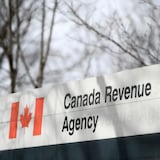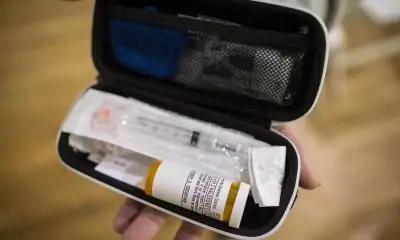Early on in the pandemic, in 2021, Hugh Potter ate dinner and watched TV next to his wife while she coughed violently from COVID-19, yet he never even sniffled.
It’s been thought that some people may not have gotten COVID because they were careful to avoid exposure. Alternatively, some people may have been infected but showed no symptoms. Another possibility is that some people have a genetic advantage that makes them a super-dodger.
Bloody lucky,
Potter, 68, said. Where I work, I think almost everyone has had it.
A few didn’t believe the Pickering, Ont., resident has escaped it since the early years of the pandemic.
Now, experts peering into the genes of such rare people have gained some surprising insights.
Last week, scientists writing in the journal Nature (new window) described high activity of a specific gene in people who didn’t get infected. And in a complementary research project, Potter provided DNA from saliva samples to researchers at McGill University Health Centre looking for those with a golden armour against the virus.
Researchers hope by better understanding early immune responses, it could help with developing nasal spray forms of vaccines for the coronavirus, similar to the existing FluMist to prevent influenza.
As much as people may wish to forget the pandemic emergency, the virus is still with us (new window) and kills about 20 people a week in Canada. The World Health Organization (new window) reported more than 2,600 new fatalities in April, bringing total confirmed cases to over 775 million including more than seven million deaths globally.
Voluntary infection
To gain some leads into what makes people super-dodgers, in March 2021, investigators with the UK COVID-19 Human Challenge study administered a low dose of the original form of SARS-CoV-2 through the nose to 36 healthy adult volunteers and then closely tracked how long it took their immune cells to kick into gear. None were previously exposed to the virus or vaccinated.
The 16 participants with detailed monitoring of their blood and nose fell into three groups:
- Six developed a sustained infection and fell ill.
- Three became infected but quickly cleared the virus.
- Seven never tested positive on the gold standard PCR test, which shows they successfully prevented infection.
Christopher Chiu, a professor of infectious diseases at Imperial College London, and his co-authors saw high levels of activity in a gene called HLA-DQA2. They think the gene helps flag invaders to the immune system so it can quickly destroy the virus.
For medical researchers, the study offers a step-by-step look at what happens in the immune responses to the virus in both the nose and blood and their interaction.
Location, location, location
Immunologists who weren’t involved in the U.K. study say they’re not sure why or how that specific gene offers protection.
If you had asked me to bet money on the genes involved in the protection, they’re not the ones I would have chosen,
said professor Dawn Bowdish, who holds the Canada Research Chair in Aging and Immunity at McMaster University in Hamilton.
The realtor’s motto of location, location, location applies, Bowdish said, because our nose, blood and lungs all differ in the type and timing of immune responses.
For instance, the vaccines we get in the arm are designed to trigger our immune system to mount a response as part of adaptive immunity.
HLA genes take up the trigger and present it to fighter cells of the immune system.
While the particular HLA in the study was better at blocking infection in COVID, it isn’t necessarily better overall since it is also associated with some diseases like lupus and rheumatoid arthritis, said Dr. Lynora Saxinger, an infectious diseases specialist at the University of Alberta.
In people who got a sustained infection in the study, it took their immune systems a while to concentrate efforts in the nasal mucosa lining areas like the nose, Saxinger said. In contrast, findings from those who mounted the fastest immune response could invigorate the field of nasal vaccines.
Blocking infection
Teams of researchers at McMaster (new window) and the University of Ottawa (new window) are among those aiming to design nasal spray or puffer forms of inhaled vaccines to not only prevent the risk of severe illness requiring hospitalization and death from COVID — as current vaccines do — but to block infection altogether.
Bowdish said scientists used to think turning on immune cells in the nose would be enough to kill the virus. But in the new study from England, cells involved in recruiting immune reactions in the mouth, nose and lungs were all important.
We are hoping to move to a world where we use inhaled vaccines or nasal vaccines, and this gives us some hints about what specific … immune genes we want those vaccines to turn on to help protect us,
Bowdish said.
WATCH | Vulnerability from age still holds:
Début du widget Widget. Passer le widget ?
Fin du widget Widget. Retourner au début du widget ?
Age still best determines when to get COVID vaccines, new research suggests
It’s been four years since COVID-19 was declared a pandemic, and new research suggests your age may determine how often you should get a booster shot.
Saxinger called the opportunity to block infection really big,
adding understanding how to clear the virus early is also important to prevent asymptomatic spread.
The pandemic landscape of variants and immunity from vaccinations is now very different than when the volunteers were exposed in the study. Some people come down with COVID repeatedly as variants evolve to dodge immune defences. And COVID illness continues to push some older, vulnerable individuals over the edge when hospitalized, doctors say.
Next, the British researchers plan to test the potential of several nasal spray vaccines against the family of coronaviruses that includes SARS-CoV-2, MERS and four seasonal common cold viruses in other human challenge trials (new window).
There might be some kind of common features that that would allow you to consider preventative or very early treatment,
Saxinger said.

























